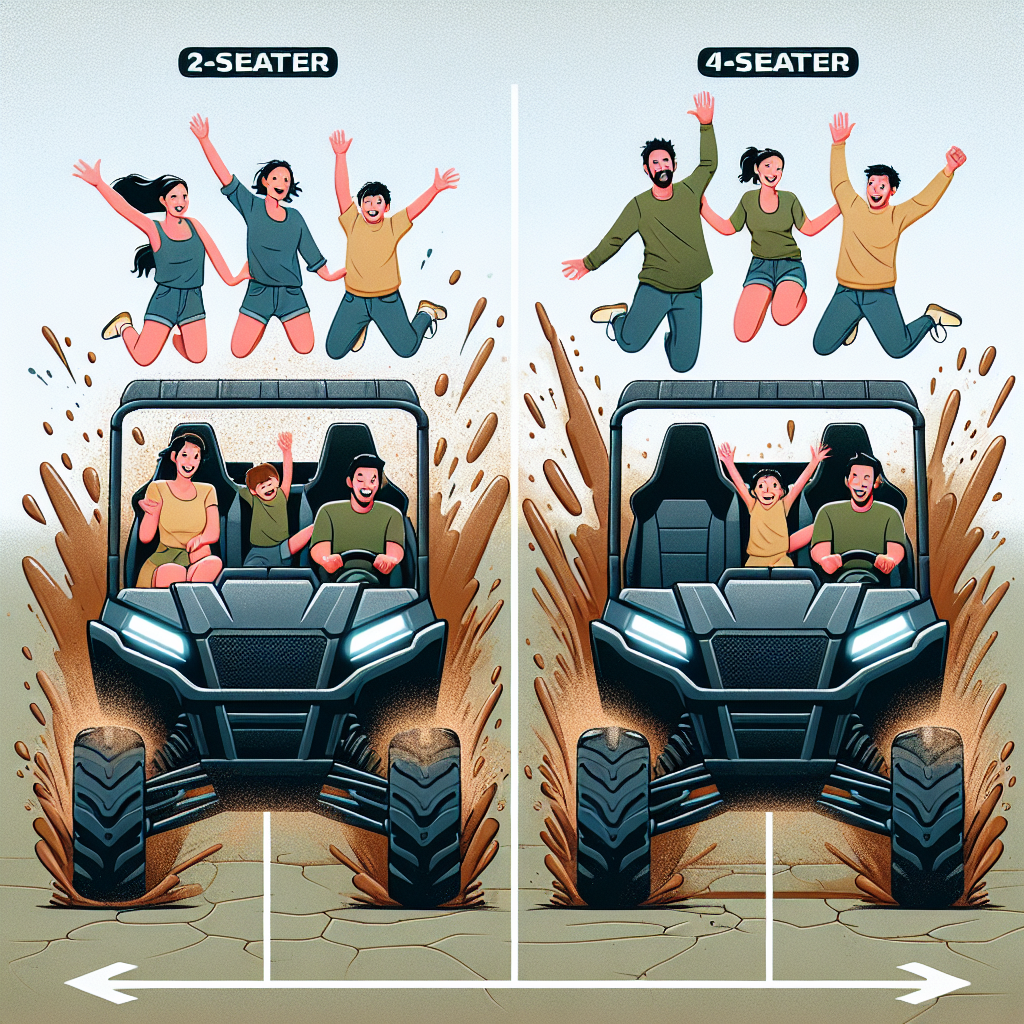2‑Seater vs 4‑Seater UTVs: Which Is Better for Family?

-
Table of Contents
“2-Seater vs 4-Seater UTVs: Choose the Perfect Ride for Family Adventures!”
When it comes to choosing the right UTV (Utility Task Vehicle) for family outings, the decision often boils down to the number of seats. 2-seater and 4-seater UTVs each offer distinct advantages and disadvantages that cater to different needs and preferences. A 2-seater UTV is typically more compact, agile, and easier to maneuver, making it ideal for solo adventures or couples. In contrast, a 4-seater UTV provides ample space for families or groups, allowing for shared experiences and the ability to transport more passengers comfortably. This introduction explores the key differences between 2-seater and 4-seater UTVs, helping families determine which option best suits their lifestyle and recreational activities.
Space Considerations: 2-Seater vs 4-Seater UTVs
When considering the purchase of a Utility Task Vehicle (UTV) for family use, one of the most significant factors to evaluate is the space offered by 2-seater versus 4-seater models. The choice between these two configurations can greatly influence the overall experience, comfort, and practicality of the vehicle, particularly for families who may have varying needs based on their activities and the number of passengers they typically transport.
To begin with, 2-seater UTVs are often more compact and agile, making them ideal for navigating tight trails and confined spaces. Their smaller size can be advantageous in off-road environments where maneuverability is essential. Additionally, the reduced weight of a 2-seater can lead to improved performance, including better acceleration and handling. However, while these vehicles excel in agility, they may fall short in accommodating larger families or groups. For families with only one or two children, a 2-seater may suffice, but as family dynamics change or if friends are included in outings, the limitations of space can quickly become apparent.
On the other hand, 4-seater UTVs provide a more spacious interior, allowing for additional passengers without compromising comfort. This extra seating capacity is particularly beneficial for families who enjoy group outings, whether it be for recreational activities such as camping, fishing, or simply exploring nature. The ability to transport more people can enhance the overall experience, fostering a sense of togetherness and shared adventure. Moreover, many 4-seater models are designed with additional storage options, which can be crucial for carrying gear, supplies, or picnic items, thereby making them more versatile for family excursions.
Transitioning from the number of seats to the layout, it is important to note that the design of the seating arrangement can also impact the comfort level of passengers. In 4-seater UTVs, the seating is often arranged in a side-by-side configuration, which can facilitate conversation and interaction among passengers. This layout not only enhances the social aspect of riding together but also allows for easier access to the vehicle, as passengers can enter and exit without climbing over one another. Conversely, 2-seater models may require more effort to get in and out, especially if the vehicle is equipped with additional features that take up space.
Furthermore, the choice between a 2-seater and a 4-seater UTV can also be influenced by the intended use of the vehicle. For families who primarily use their UTV for work-related tasks, such as farm operations or property maintenance, a 2-seater may be sufficient if the primary operator is the only one needing transport. However, for those who envision using their UTV for family outings or recreational purposes, investing in a 4-seater can provide greater flexibility and enjoyment.
In conclusion, the decision between a 2-seater and a 4-seater UTV ultimately hinges on the specific needs and lifestyle of the family. While 2-seater models offer agility and ease of handling, they may not accommodate larger groups comfortably. In contrast, 4-seater UTVs provide ample space and versatility, making them a more suitable choice for families who prioritize shared experiences and the ability to transport multiple passengers. By carefully considering these space considerations, families can make an informed decision that aligns with their unique requirements and enhances their outdoor adventures.
Safety Features: Comparing 2-Seater and 4-Seater UTVs
When considering the safety features of 2-seater and 4-seater UTVs, it is essential to recognize that both configurations offer distinct advantages and potential drawbacks. Safety is a paramount concern for families, especially when engaging in off-road adventures. Therefore, understanding how each type of UTV addresses safety can significantly influence purchasing decisions.
To begin with, 2-seater UTVs are often designed with a more compact frame, which can enhance maneuverability and stability. This compactness allows for a lower center of gravity, reducing the likelihood of rollovers during sharp turns or uneven terrain. Additionally, many 2-seater models come equipped with advanced safety features such as reinforced roll cages, seat belts, and harness systems that are specifically designed to secure occupants in place. These features are crucial in minimizing injury during sudden stops or collisions. Furthermore, the smaller size of 2-seater UTVs can make them easier to navigate through tight trails, which can be particularly beneficial in avoiding potential hazards.
On the other hand, 4-seater UTVs provide the advantage of accommodating more passengers, making them an appealing choice for families. However, this increased capacity can sometimes lead to a trade-off in terms of safety. The larger frame of a 4-seater can result in a higher center of gravity, which may increase the risk of rollovers, especially when navigating steep inclines or uneven surfaces. Nevertheless, many manufacturers have recognized this concern and have implemented enhanced safety features in their 4-seater models. For instance, some UTVs come with advanced stability control systems that help maintain traction and balance, thereby reducing the risk of accidents.
Moreover, the safety of passengers in a 4-seater UTV is often bolstered by the inclusion of additional safety features such as side nets or doors, which help prevent ejection during sudden maneuvers. These features are particularly important for families with young children, as they provide an extra layer of protection. Additionally, many 4-seater UTVs are equipped with multiple seat belts and harnesses, ensuring that all passengers are securely fastened during rides. This focus on passenger safety is crucial for families who prioritize the well-being of their loved ones while enjoying outdoor activities.
Transitioning from the structural aspects of safety, it is also important to consider the role of driver visibility in both types of UTVs. Generally, 2-seater UTVs offer a more direct line of sight for the driver, which can enhance awareness of the surrounding environment. This improved visibility can be a significant safety advantage, particularly in off-road conditions where obstacles may be less predictable. Conversely, while 4-seater UTVs may have slightly obstructed views due to their larger size, many models are designed with large windshields and adjustable seating arrangements that can help mitigate this issue.
In conclusion, both 2-seater and 4-seater UTVs present unique safety features that cater to different family needs. While 2-seater models may offer enhanced stability and maneuverability, 4-seater options provide the benefit of accommodating more passengers with additional safety measures. Ultimately, the choice between the two will depend on the specific requirements of the family, including the number of passengers, the types of terrain they plan to navigate, and their overall safety priorities. By carefully evaluating these factors, families can make an informed decision that best suits their off-road adventures.
Cost Analysis: 2-Seater vs 4-Seater UTVs for Family Use
When considering the purchase of a Utility Task Vehicle (UTV) for family use, one of the most significant factors to evaluate is the cost associated with both 2-seater and 4-seater models. Understanding the financial implications of each option can help families make an informed decision that aligns with their needs and budget.
To begin with, the initial purchase price of a UTV can vary considerably between 2-seater and 4-seater models. Generally, 2-seater UTVs tend to be less expensive than their 4-seater counterparts. This price difference can be attributed to the additional materials and engineering required to accommodate extra seating and safety features in 4-seater models. For families on a tight budget, opting for a 2-seater UTV may seem like the more economical choice. However, it is essential to consider the long-term implications of this decision, particularly in terms of family outings and activities.
Moreover, while the upfront cost of a 2-seater UTV may be lower, families should also factor in the potential need for additional vehicles if they frequently travel with more than two people. In such cases, the cost of purchasing a second UTV or renting one for family excursions can quickly add up, potentially negating the initial savings from choosing a 2-seater. Therefore, it is crucial to assess how often the UTV will be used for family outings and whether the 2-seater model will adequately meet those needs.
In addition to the purchase price, ongoing costs such as maintenance, insurance, and fuel consumption should also be considered. Typically, 2-seater UTVs may have lower maintenance costs due to their simpler design and fewer components. However, this advantage can be offset by the increased usage of a second vehicle if a family frequently requires more seating capacity. On the other hand, 4-seater UTVs, while potentially more expensive to maintain, can provide a more convenient solution for larger families or those who often travel with friends. This convenience can lead to fewer trips and lower overall fuel costs, as a single vehicle can accommodate everyone.
Insurance costs can also differ between the two types of UTVs. Generally, 4-seater models may incur higher insurance premiums due to their increased value and the higher risk associated with carrying more passengers. Families should obtain insurance quotes for both types of UTVs to understand the financial implications fully. Additionally, it is wise to consider the resale value of each model. Typically, 4-seater UTVs may retain their value better due to their versatility and appeal to a broader market, which can be an essential factor for families looking to upgrade in the future.
Ultimately, the decision between a 2-seater and a 4-seater UTV for family use hinges on a careful analysis of both initial and ongoing costs. While a 2-seater may present a lower entry point, families must weigh this against their specific needs for space and functionality. Conversely, a 4-seater UTV, despite its higher price tag, may offer greater long-term value and convenience for larger families or those who frequently engage in group activities. By thoroughly evaluating these financial aspects, families can make a well-informed decision that best suits their lifestyle and budgetary constraints.
Q&A
1. **What are the main advantages of a 2-seater UTV for family use?**
A 2-seater UTV is typically more compact, easier to maneuver, and often has better performance in terms of speed and agility, making it ideal for recreational activities and tight trails.
2. **What are the benefits of choosing a 4-seater UTV for family outings?**
A 4-seater UTV provides more seating capacity, allowing families to ride together comfortably, making it better for group outings and ensuring that everyone can participate in the adventure.
3. **Which UTV option is generally more cost-effective for families?**
A 2-seater UTV is usually less expensive to purchase and maintain compared to a 4-seater, making it a more budget-friendly option for smaller families or those who prioritize performance over capacity.In conclusion, the choice between a 2-seater and a 4-seater UTV largely depends on family size and intended use. A 4-seater UTV is better suited for families who frequently ride together, offering more space and comfort for passengers. However, a 2-seater UTV may be more agile and easier to maneuver, making it ideal for solo riders or couples. Ultimately, the best option will depend on individual preferences, riding habits, and the need for passenger capacity.





